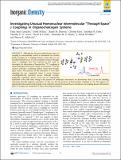Investigating unusual homonuclear intermolecular “through-space” J couplings in organochalcogen systems
Date
07/11/2016Author
Grant ID
EP/F018096/1
614290 - EXONMR
EP/M022501/1
WM150021
IN-2012-094
Keywords
Metadata
Show full item recordAbstract
Although the electron-mediated spin-spin or J coupling is conventionally viewed as transmitted via covalent bonds, examples of J couplings between atoms that are not formally bonded but are in close proximity (termed “through-space” J couplings) have been reported. In this work, we investigate the observation of homonuclear 31P J couplings in organochalcogen heterocycles, which occur between 31P in two separate molecules, confirming without doubt their through-space nature. The presence of this interaction is even more surprising for one compound, where it occurs between crystallographically-equivalent species. Although crystallographically-equivalent species need not be magnetically equivalent in the solid state, owing to the presence of anisotropic interactions, we demonstrate that it is not the shielding anisotropy that lifts magnetic equivalence in this case, but the presence of heteronuclear couplings to 77Se. We support our experimental observations with periodic scalar-relativistic density functional theory (DFT) calculations, and coupling density deformation (CDD) plots to visualize the mechanism of these interesting interactions.
Citation
Sanz Camacho , P , McKay , D , Dawson , D M , Kirst , C , Yates , J R , Green , T F G , Cordes , D B , Slawin , A M Z , Woollins , J D & Ashbrook , S E 2016 , ' Investigating unusual homonuclear intermolecular “through-space” J couplings in organochalcogen systems ' , Inorganic Chemistry , vol. 55 , no. 21 , pp. 10881-10887 . https://doi.org/10.1021/acs.inorgchem.6b01121
Publication
Inorganic Chemistry
Status
Peer reviewed
ISSN
0020-1669Type
Journal article
Description
We would like to thank the ERC (EU FP7 Consolidator Grant 614290 “EXONMR”) and EPSRC for computational support through the Collaborative Computational Project on NMR Crys-tallography (CCP-NC), via EP/M022501/1 and EP/J501542/1. SEA would like to thank the Royal Society and the Wolfson Foundation for a merit award. We gratefully acknowledge support from the Leverhulme Trust (IN-2012-094). We would also like to acknowledge Professor David Bryce for helpful discussions. The UK 850 MHz solid-state NMR Facility used in this research was funded by EPSRC and BBSRC (contract reference PR140003), as well as the University of Warwick including via part funding through Birmingham Science City Advanced Materials Projects 1 and 2 supported by Advantage West Midlands (AWM) and the European Regional Development Fund (ERDF). Collaborative assistance from the 850 MHz Facility Manager (Dinu Iuga, Uni-versity of Warwick) is acknowledged. J-coupling calculations for 1 were performed on the ARCHER UK National Supercomputing Service, and were supported by CCP-NC. The research data (and/or materials) supporting this publication can be accessed at DOI: http://dx.doi.org/10.17630/6871d21d-e523-4946-9445-2a95e923d6e9.Collections
Items in the St Andrews Research Repository are protected by copyright, with all rights reserved, unless otherwise indicated.

